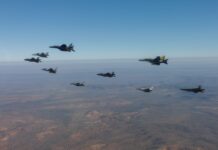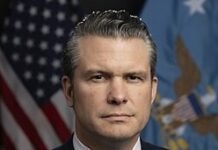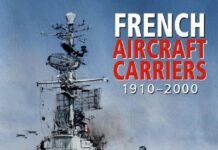
Chris Cartledge, who has died aged 100, was a Fleet Air Arm pilot who flew the ‘bent wing bastard’ on operations against the Germans and the Japanese in the Second World War, and aged 20 was awarded the Distinguished Service Cross. He qualified twice as a member of the Goldfish Club whose members had ditched at sea.
In August 1944 Cartledge took part in Operation Goodwood, the attack on the German battleship Tirpitz which was hiding in the Norwegian fjords. Goodwood was the largest scale bombing raid by the FAA so far in the war, over a period of several days, when many newly qualified naval aviators were blooded. To maintain surprise, a number of faster Corsairs of 1842 Naval Air Station carried 1,000 lbs: it was not known whether they could even take-off in the apparent wind but, using the full length of Formidable’s flightdeck, they flew at sea level to avoid German radar before climbing over the mountains. The Corsairs led the attack, surprising Tirpitz before the Germans could generate a smokescreen and divebombing from 10,000ft at a 45º angle. Cartledge was third in line behind his commanding officer, Tony ‘Judy’ Garland. Cartledge recalled that the air was thick with black bursts of flak and yellow balls of tracer from blazing guns on the side of the fjord and from Tirpitz as she filled the view from his cockpit and appeared to slip past his head. There were funnels of frothing foam from exploding bombs: his wingman, John French, was blasted out of the sky, and Cartledge pulled away so hard that he almost blacked out, he sped along the floor of the fjord as bullets kicked up the surface of the water.
Cartledge was awarded the DSC: he was puzzled but decided that a few medals were sprinkled about and he accepted the award on behalf of all his squadron.
Next, 1842 NAS deployed in Formidable to the Far East, where they took part in operations against Japanese islands and the mainland. He was airborne when Formidable was hit by a Kamikaze pilot on May 4, 1945, and had to land on the carrier Indomitable. Despite three killed and forty-seven wounded and eleven aircraft destroyed, Formidable, thanks to her armoured flightdeck was quickly serviceable again.
Then on July 17, 1945, his aircraft was hit by anti-aircraft fire as he strafed the Matsushima airfield on the mainland of Japan. He struggled back to Formidable, thinking his hydraulics had been damaged and opting to bale out close to ‘mother.’ Finding that he was unable to release the cockpit hood, he circled the ship waiting for her to complete emergency landing preparations, all the while continuing to try to jettison the hood. Letting go of the control column to enable him to twist round and get both hands on the canopy, his Corsair cartwheeled and crashed into the sea. Luckily, the impact snapped Cartledge’s parachute and seat straps, knocked off the canopy and threw him clear, when he was picked up by an accompanying destroyer, and suffered no more than a few cuts and bruises. All he remembered was coming to, floating on the water in his Mae-west, and watching the last of his plane sinking under the water.
On September 19, 1945, at war’s end as Formidable steamed into Sydney harbour, Cartledge reflected that if the eighteen pilots in the first squadron photograph, only nine were alive: “I hope they weren’t wasted but one shouldn’t forget, otherwise what little we did achieve will definitely be wasted.”
Christopher Reginald Cartledge was born in Egham, Surrey and educated at City of London school, then at its wartime home at Marlborough college. His father had been shot down while flying a Sopwith Camel of the Royal Flying Corps and spent much of the much of the Fist World War as a prisoner of war.
Young Cartledge volunteered for the Fleet Air Arm as soon as he could and on his 18th, birthday started his naval training. He first flew the de Havilland Tiger Moth before taking passage in RMS Queen Mary to continue his training in Canada.
Returning to Britain, on August 18, 1943, Cartledge was attempting his first ever deck landing in a Sea Hurricane on the carrier Argus off Scotland, when, going round on his fourth try, he veered to starboard off the centreline of the flightdeck, and the ship’s radio mast sliced three feet off his starboard wing. His aircraft slid over the side and made a graceful, curved descent into the Clyde: he was taken aboard a destroyer, given dry clothes and filled up with gin. A month later he returned to make his first successful decklanding.
Later, while based at HMS Nightjar, as RNAS Inskip was known, Cartledge borrowed an unfamiliar Sea Skua in order to keep a date with a Wren in Liverpool. Unfortunately, he collided with a Seafire while taxi-ing, causing minor damage, and on returning was charged and court-martialled. The court was unimpressed by his defence which was that the Seafire’s camouflage was so good that he could not see it against the background of a muddy airfield, but his CO thought he was too good a pilot to lose and spoke up for him strongly in front of senior officers. He was found guilty but only lost two months’ seniority.
In 1944 Cartledge returned to North America to Maine, Brunswick to learn to fly the long-nosed, high-performance Chance Vought Corsair. It was so difficult to handle in the approach to carrier landings that it became known as the ‘bent wing bastard’ or ‘the ensign killer’ and it was given to the USMC and to the RN to master. Adopting a curved approach to ensure that the flightdeck was kept in sight as long as possible, young FAA pilots like Cartledge tamed the Corsair and it was brought into service on small British carriers before it was cleared for use in the USN.
Postwar he joined his grandfather’s company business, A Cartledge and Sons, buying and selling non-ferrous metals.
As a youth Cartledge was rebellious, but in the early 60s he converted to Catholicism and his religion found practical expression as a volunteer with Meals on Wheels and the St Vincent de Paul society, as organist and choir director, and treasurer or chairman of the churches where he worshipped. Until a year ago he travelled long distances to visit family members and called on former neighbours in their care homes .
Cartledge’s story and that of his flying companions in the British Pacific Fleet is told in Will Iredale’s The Kamikaze Hunters (2015).
In 1948 he married Dorothy Taylor, a calligrapher and bookbinder, who he met while he was a student at Goldsmiths Art College: she died in 2009. Even at school Cartledge showed himself to be a talented musician who sang and played the organ and the piano and he is survived by his three very musical daughters and a son who a computer consultant.
Christopher Cartledge, born December 16, 1923, died January 21, 2024.



